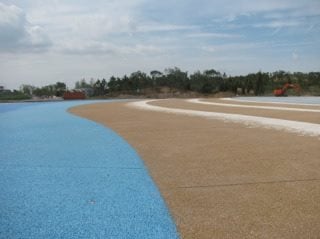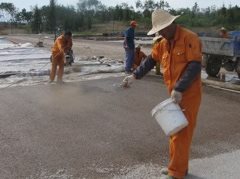- Staining Concrete
- Stamped Concrete
- Concrete Overlays
- Concrete Resurfacing
- Concrete Polishing
- Concrete Dyes
- Colored Concrete
- Indoor Concrete
- Concrete Floors
- Concrete Countertops
- Garage Floor Coatings
- Furniture, Sinks, Fire Bowls
- Basement Floors
- Outdoor Concrete
- Concrete Patios
- Concrete Driveways
- Concrete Pool Decks
- Outdoor Kitchens & Counters
- Outdoor Fireplace
- Concrete Walkways
- Concrete Pavers
- Concrete Walls
- Repair & Maintenance
- Foundation Repair
- Concrete Crack Repair
- Concrete Sealers
- Building with Concrete
- Concrete Homes
- Concrete Basements
- Decorative Concrete
- Fire Resistant
Pervious Concrete Pavement Replicates a Wave-Washed Beach
For the 2013 World Landscape Art Exhibition, Jinzhou, China, is using pervious concrete to depict its beautiful beach sceneryTwo years ago I had the opportunity to visit the Olympic Park in Beijing, which was built for the 2008 Summer Olympics. I was amazed by the large amount of pervious concrete and void-structured concrete that was installed as part of the green building initiatives issued by the Chinese governing bodies. On a more recent trip to China, I had the opportunity to take my family and visit this same site. I was pleased to see the pervious concrete holding up well in this environment where freeze-thaw cycles are common during the winter months.
One thing that amazes me about China is the size of the projects there. Large parks and public recreation areas are common, so it is normal to have projects that exceed a million square feet. For these large areas, the government sees the benefits of specifying sustainable paving systems like pervious concrete.
In 2013, the World Landscape Art Exhibition will be held in Jinzhou, China. As preparation for the exhibition, the city specified pervious concrete for a large portion of the paving that will be used during the event. Jinzhou rests along the sea, and is often visited by foreign tourists and by locals seeking a change of pace from the traffic of Beijing and Shanghai.
During the planning phase of the World Landscape Art Exhibition, local contractor Wang Lizhong from Orange Stone proposed a pavement design that incorporated the natural surroundings of Jinzhou. After samples were produced, it was decided that pervious concrete would be used to depict the beautiful beach scenery that Jinzhou has to offer. The majority of the project entailed the use of integrally colored pervious concrete with various shades of blue representing the sea. A unique challenge of the project was how to depict, using pervious concrete, the white waves of the sea hitting the beach.
How to build a beachTo accomplish this effect, custom-colored buff and pure white aggregates were selected for the project and batched at the plant in two separate mixers. These two pervious mixes were placed at the same time right next to each other, with great care taken to keep the mixes separate. Once the pervious concrete was placed with a roller screed, seeding of the white aggregate mix was introduced into the buff aggregate section. This surface seeding of the white aggregate was the key to a smooth transition between the concrete sections containing the buff-colored aggregates and the white aggregates, creating the effect of white seawater washing onto the sand.
Author Brian Farnsworth, BGI Technical Services
Learn more about pervious concrete
See more international concrete projects






